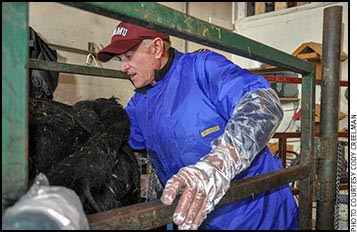Calving Do’s and Don’ts
There are many ‘traditional’ ways to assist a birth — some are helpful and some that are not.
Veterinarian Bill Lias, Interstate Vet Clinic, Brandon, S.D., says he has seen a variety of ways to assist cows at calving over the years. Some have been improvements, while a few others he’d rather not see again.

The option of doing a C-section is something veterinarians and producers consider sooner. When encountering dystocia, it is important to thoroughly examine the cow to determine the cause of delay.
“As I’ve aged and gained experience, there are some things I do differently now, too. For instance, the option of doing a C-section is something veterinarians and producers today consider sooner,” he says. In the past, people tried harder and longer to get a calf out before resorting to surgery, and sometimes those calves didn’t survive and/or the cow was irreparably injured.
“As technology and surgical methods improved, C-sections today are fairly straightforward and routine,” he says. Cows have an excellent recovery rate and so do the calves if surgery is done early while the calf is still alive.
“Earlier in my career, some of the dystocias we dealt with were horrible wrestling matches,” Lias recalls. “When we got done, we wished we’d done a C-section because it would have been a lot better for everyone.”
When encountering a dystocia, it is important to take time to do a thorough exam and to figure out why the cow is not having that calf.
“Determine the presentation of the calf and how big it is. How big is the cow? Is it a fetal oversize issue or a malposition? Then make your decision on which route would be the best, and make a good decision before you get into a wreck,” he advises.
“If you’ve already applied a lot of traction and the calf is partway out and locked at the hips, it’s too late to do a C-section. You’ve already messed things up,” he explains.
Today, most veterinarians are very competent, so producers should have no aversion to doing a C-section, says Lias. In remote areas where it can be difficult to get a veterinarian in a timely manner, some ranchers have learned to do the surgery themselves.
Another mistake some people make is excessive use of traction. Many veterinary schools are going so far as to discourage students from using a calf puller or mechanical calf jack. Lias says, however, there is a place for a calf puller when dealing with a backward calf or when pulling a calf alone.
“If you took my calf puller away, there would be some calves I just couldn’t get because I’m not as tough as I used to be,” he says.
Small people or females, working alone, may need the added traction provided by a calf puller. Judicious use of a puller can be very helpful, and then there is no reason to use excessive traction with a tractor or four-wheeler.
“There is as much art as science in doing obstetrical work, along with knowledge that comes from experience and seeing a lot of cases. You get a feel for whether a calf will fit through or not, keeping in mind that the largest part of the calf is the pelvis, which is why a hip lock can be a problem or a large calf coming backward,” he says.
It’s also important to put chains on correctly, using two loops on the leg. Attach the first loop above the ankle joint then use a half hitch around the pastern. This keeps the tension more in line with the long axis of the bone and offers less chance to injure the leg.
“Improper traction can fracture the bone or injure the growth plate,” says Lias.

Editor’s Note: Heather Smith Thomas is a freelance writer and cattlewoman from Salmon, Idaho.






